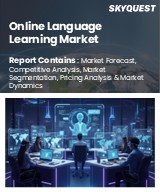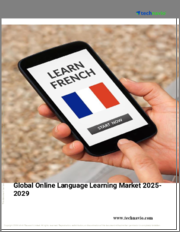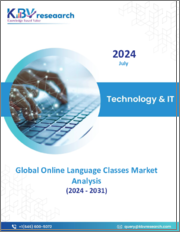
|
시장보고서
상품코드
1486914
세계의 온라인 언어 학습 시장 규모, 점유율, 예측 및 동향 분석 : 학습 모드별, 연령대별, 언어별, 최종 사용자별, 지역별 예측(-2031년)Online Language Learning Market Size, Share, Forecast, & Trends Analysis by Learning Mode, Age Group, Language, End User, and Geography - Global Forecast to 2031 |
||||||
언어 학습은 학습자가 여러 언어로 의사소통할 수 있는 능력을 습득하는 과정입니다. 온라인 언어 학습은 디지털 플랫폼을 통해 새로운 언어 기술을 습득하거나 기존 기술을 향상시키는 과정을 말합니다. 이 학습 모드에서는 인터넷을 통해 다양한 리소스와 도구에 접근할 수 있기 때문에 학습자는 장소에 구애받지 않고 자신의 속도에 맞추어 언어를 학습할 수 있습니다. 최근 몇 년동안 이러한 학습 모드는 언어 전문가와 컴퓨터 지원 언어 학습(CALL) 분야에서 큰 주목을 받고 있습니다. 또한, 온라인 언어 학습 과정은 더 나은 교육을 받기 위해 기타 국가로 이주하는 학생들이 커뮤니케이션 능력을 향상시키기 위해 널리 채택하고 있습니다.
온라인 언어 학습 시장의 성장은 세계화와 국경을 초월한 커뮤니케이션의 필요성 증가, e러닝 시장의 성장, e러닝에 인공지능의 침투로 인해 온라인 언어 학습 시장의 성장이 이루어지고 있습니다. 그러나 데이터 보안 및 개인 정보 보호에 대한 우려는 이 시장의 성장을 억제하고 있습니다. 또한, 교육 분야에 대한 지출 증가, 인터넷 및 스마트폰 보급률 증가, 다국적 기업의 다국어 직원에 대한 선호도 증가는 이 시장에서 사업을 운영하는 기업에게 성장 기회를 제공할 것으로 예상됩니다. 그러나 높은 도입 비용은 시장 성장에 영향을 미치는 큰 도전 과제입니다. 또한, 유연한 가격 체계와 웨어러블 기술의 도입은 온라인 언어 학습 시장의 두드러진 추세입니다.
온라인 언어 학습 시장은 학습 모드(자가 학습 앱/어플, 튜터링), 연령대(13세 미만, 13-17세, 18-20세, 21-30세, 31-40세, 40세 이상), 언어(영어, 프랑스어, 스페인어, 중국어, 독일어, 이탈리아어, 일본어, 한국어, 기타), 최종 사용자(개인 학습자, 교육기관, 정부기관, 기업 학습자), 지역별로 세분화되어 있다, 일본어, 한국어, 기타), 최종 사용자(개인 학습자, 교육기관, 교육기관, 정부기관, 기업 학습자), 지역별로 구분됩니다. 또한, 업계 경쟁업체를 평가하고 지역 및 국가별 시장도 분석합니다.
목차
제1장 서론
제2장 조사 방법
제3장 주요 요약
- 개요
- 시장 분석 : 학습 모드별
- 시장 분석 : 연령층별
- 시장 분석 : 언어 별
- 시장 분석 : 최종사용자별
- 시장 분석 : 지역별
- 경쟁 분석
제4장 시장 인사이트
- 개요
- 시장 성장에 대한 영향요인
- 동향
제5장 온라인 언어 학습 시장 평가 : 학습 모드별
- 개요
- 자기 학습 앱
- 개별 지도
- 맨투맨 학습
- 그룹 학습
제6장 온라인 언어 학습 시장 평가 : 연령층별
- 개요
- 13세 미만
- 13-17세
- 18-20세
- 21-30세
- 31-40세
- 40세 이상
제7장 온라인 언어 학습 시장 평가 : 언어별
- 개요
- 영어
- 스페인어
- 프랑스어
- 베이징어
- 독일어
- 일본어
- 이탈리아어
- 아랍어
- 한국어
- 기타
제8장 온라인 언어 학습 시장 평가 : 최종사용자별
- 개요
- 개인 학습자
- 교육기관
- K-12
- 고등교육 기관
- 정부기관
- 기업 학습자
제9장 온라인 언어 학습 시장 평가 : 지역별
- 개요
- 아시아태평양
- 중국
- 일본
- 인도
- 한국
- 인도네시아
- 호주 및 뉴질랜드
- 대만
- 홍콩
- 싱가포르
- 말레이시아
- 베트남
- 기타 아시아태평양
- 유럽
- 독일
- 프랑스
- 이탈리아
- 영국
- 스페인
- 러시아
- 폴란드
- 네덜란드
- 스웨덴
- 오스트리아
- 벨기에
- 스위스
- 핀란드
- 노르웨이
- 터키
- 아일랜드
- 룩셈부르크
- 기타 유럽
- 북미
- 미국
- 캐나다
- 중동 및 아프리카
- 사우디아라비아
- 아랍에미리트(UAE)
- 기타 중동 및 아프리카
- 라틴아메리카
- 멕시코
- 브라질
- 칠레
- 아르헨티나
- 콜롬비아
- 페루
- 기타 라틴아메리카
제10장 경쟁 분석
- 개요
- 주요 성장 전략
- 경쟁 벤치마킹
- 경쟁 대시보드
- 시장 점유율 분석
제11장 기업 개요(기업 개요, 재무 개요, 제품 포트폴리오, 전략적 전개)
- Babbel GmbH
- Duolingo, Inc.
- Enux Education Limited(FluentU)
- Rosetta Stone LLC
- Busuu Limited(A Subsidiary of Chegg, Inc.)
- ELSA Corp.
- Open Education LLC
- New Oriental Education & Technology Group Inc.
- Berlitz Corporation
- Mango Languages
- McGraw Hill LLC
- Cambly Inc.
- Houghton Mifflin Harcourt Publishing Company(A Subsidiary of Veritas Capital Fund Management, L.L.C.)
- Cambridge University Press & Assessment
- inlingua International Ltd.
- Transparent language, inc.
- The British Council
- ATI STUDIOS A.P.P.S. S.R.L(Mondly)(A Subsidiary of Pearson Plc)
- Memrise Limited
(주 : 주요 5개사의 SWOT 분석을 제공)
제12장 부록
LSH 24.06.05The research report titled, 'Online Language Learning Market by Learning Mode (Self-learning Apps & Applications, Tutoring), Age Group, Language (English, Mandarin, Spanish), End User (Individual Learners, Educational Institutions), and Geography-Global Forecast to 2031,' provides an in-depth analysis of the online language learning market in five major geographies and emphasizes on the current market trends, size, and share, recent developments, and forecasts till 2031. The online language learning market is projected to reach $44.9 billion by 2031, at a CAGR of 19.5% during the forecast period 2024-2031.
Language learning is a process by which learners develop the ability to communicate in more than one language. Online language learning refers to the process of acquiring new language skills or enhancing existing ones through digital platforms. This mode of learning leverages the internet to provide access to a wide array of resources and tools, enabling learners to study a language at their own pace from any location. In recent years, these formats have been attracting serious attention from the language profession and the field of computer-assisted language learning (CALL). Furthermore, online language learning courses are widely adopted by students to improve communication skills as they move to different countries for better education.
The growth of the online language learning market is driven by globalization and the growing need for cross-border communication, the growing e-learning market, and the penetration of artificial intelligence in e-learning. However, data security and privacy concerns restrain the growth of this market. Furthermore, the increasing expenditure on the education sector, rising penetration of the internet and smartphone user base, and increasing preference for multilingual employees by multinational companies are expected to generate growth opportunities for the players operating in this market. However, high implementation costs are major challenges impacting market growth. Additionally, the flexible pricing structure and introduction of wearable technologies are prominent trends in the online language learning market.
The online language learning market is segmented based on learning mode (self-learning apps and applications and tutoring), age group (13 years, 13-17 years, 18-20 years, 21-30 years, 31-40 years, and >40 years), language (English, French, Spanish, Mandarin, German, Italian, Arabic, Japanese, Korean, and other languages), end user (individual learners, educational institutes, government institutes, and corporate learners), and geography. The study also evaluates industry competitors and analyses the regional and country-level markets.
Based on learning mode, the online language learning market is segmented into self-learning apps and applications, and tutoring. The self-learning apps and applications segment is projected to register the highest CAGR during the forecast period. The segment's large market share can be attributed to the increasing adoption of self-learning apps and information & communication technology (ICT) in educational institutions, the increasing accessibility to higher education opportunities, a rising demand for immersive and practical language practice, the growing digitalization of educational content, an expanding user base of mobile phones, the easy availability of language learning apps, online courses, and virtual tutors, and a growing demand for personalized and flexible language education experiences.
Based on age group, the online language learning market is segmented into <13 years, 13-17 years, 18-20 years, 21-30 years, 31-40 years, and >40 years. The <13 years segment is expected to register the highest CAGR during the forecast period. The growth of this segment is driven by the growing significance of learning a language at a young age, easy accessibility and better user interface for online language learning platforms, and the growing trend of gamification in language learning.
Based on language, the online language learning market is broadly segmented into English, French, Spanish, Mandarin, German, Italian, Arabic, Japanese, Korean, and other languages. The Spanish segment is expected to register the highest CAGR during the forecast period due to the high popularity of the Spanish language in many countries and it being the 3rd most widely used language on the internet. All such factors, along with the increasing need for convenient and adaptive language learning solutions and a growing number of Spanish speakers and learners, represent an increased demand for online language learning solutions.
Based on end user, the online language learning market is segmented into individual learners, educational institutes, government institutes, and corporate learners. The individual learners segment is expected to register the highest CAGR during the forecast period. The segment's large market share is attributed to the widespread adoption of smart devices, increasing access to the internet, online language learning providers' increasing live content transmission on the internet to enhance brand engagement and reach students, the proliferation of social media platforms, and the presence of numerous well-established language learning sites.
Based on geography, the online language learning market is segmented into North America, Europe, Asia-Pacific, Latin America, and the Middle East & Africa. Asia-Pacific region is projected to record the highest CAGR during the forecast period. The market growth in Asia-Pacific is driven by government initiatives to strengthen national education networks, the growing government focus on the education sector, rapidly developing economies, and increasing disposable incomes leading to increased internet penetration, which are propelling the demand for online language learning in the region.
The key players profiled in the online language learning market include Babbel GmbH (Germany), Duolingo, Inc. (U.S.), ELSA Corp. (U.S.), Enux Education Limited (China), Mango Languages (U.S.), Rosetta Stone LLC (U.S.), Open Education LLC (U.S.), New Oriental Education & Technology Group Inc. (China), Berlitz Corporation (U.S.), McGraw Hill LLC (U.S.), Cambly Inc. (U.S.), Houghton Mifflin Harcourt Publishing Company (U.S.), Cambridge University Press & Assessment (U.K.), Busuu Limited (U.K), inlingua International Ltd. (Switzerland), Transparent Language, Inc. (U.S.), The British Council (U.K), ATI STUDIOS A.P.P.S. S.R.L (Mondly) (Romania), and Memrise Limited (U.K.).
Key Questions Answered in the Report:
- Which are the high-growth market segments in terms of learning mode, age group, language, end user, and geography?
- What is the historical market size for the online language learning market across the globe?
- What are the market forecasts and estimates for the period 2024-2031?
- What are the major drivers, restraints, opportunities, and challenges in the online language learning market?
- Who are the major players in the market, and what are their market shares?
- What is the competitive landscape like in the online language learning market?
- What are the recent developments in the online language learning market?
- What are the different strategies adopted by the major players in the market?
- What are the key geographic trends, and which are the high-growth countries?
- Who are the local emerging players in the online language learning market, and how do they compete with other players?
Scope of the report:
Online Language Learning Market Assessment -by Learning Mode
- Self-learning Apps And Applications
- Tutoring
- One-on-One Learning
- Group Learning
Online Language Learning Market Assessment -by Age Group
- <13 Years
- 13-17 Years
- 18-20 Years
- 21-30 Years
- 31-40 Years
- >40 Years
Online Language Learning Market Assessment -by Language
- English
- Spanish
- French
- Mandarin
- German
- Japanese
- Italian
- Arabic
- Korean
- Other Languages
Online Language Learning Market Assessment -by End User
- Individual Learners
- Educational Institutes
- K-12
- Higher Education
- Government Institutes
- Corporate Learners
Online Language Learning Market Assessment -by Geography
- Asia-Pacific
- China
- Japan
- India
- South Korea
- Indonesia
- Australia & New Zealand
- Taiwan
- Hong Kong
- Singapore
- Malaysia
- Vietnam
- Rest of Asia-Pacific
- Europe
- Germany
- France
- Italy
- U.K.
- Spain
- Russia
- Poland
- Netherlands
- Sweden
- Austria
- Belgium
- Switzerland
- Finland
- Norway
- Turkey
- Ireland
- Luxembourg
- Rest of Europe
- North America
- U.S.
- Canada
- Middle East & Africa
- Saudi Arabia
- UAE
- Rest of Middle East & Africa
- Latin America
- Mexico
- Brazil
- Chile
- Argentina
- Colombia
- Peru
- Rest of Latin America
TABLE OF CONTENTS
1. Introduction
- 1.1. Market Definition & Scope
- 1.2. Currency & Limitations
- 1.2.1. Currency
- 1.2.2. Limitations
2. Research Methodology
- 2.1. Research Approach
- 2.2. Data Collection & Validation Process
- 2.2.1. Secondary Research
- 2.2.2. Primary Research/Interviews With Key Opinion Leaders From The Industry
- 2.3. Market Sizing And Forecasting
- 2.3.1. Market Size Estimation Approach
- 2.3.2. Growth Forecast Approach
- 2.4. Assumptions For The Study
3. Executive Summary
- 3.1. Overview
- 3.2. Market Analysis, By Learning Mode
- 3.3. Market Analysis, By Age Group
- 3.4. Market Analysis, By Language
- 3.5. Market Analysis, By End User
- 3.6. Market Analysis, By Geography
- 3.7. Competitive Analysis
4. Market Insights
- 4.1. Overview
- 4.2. Factors Affecting Market Growth
- 4.2.1. Globalization And The Growing Need For Cross-Border Communication Driving Market Growth
- 4.2.2. Growing E-learning Market Driving the Market Demand
- 4.2.3. Penetration of Artificial Intelligence In E-learning Is Driving Market Demand
- 4.2.4. Data Security and Privacy Concerns Are Expected to Restrain Market Growth
- 4.2.5. Increasing Expenditure On Education Sector Generating Growth Opportunities For Market Players
- 4.2.6. Rising Penetration of Internet And Smartphone User Base Generating Growth Opportunities For Market Players
- 4.2.7. Increasing Preference For Multilingual Employees By Multinational Companies Generating Growth Opportunities For Market Players
- 4.2.8. Lack of Digital Infrastructure In Developing Countries Impacting Market Growth
- 4.3. Trends
- 4.3.1. Flexible Pricing Structure
- 4.3.2. Introduction of Wearable Technologies
5. Online Language Learning Market Assessment-by Learning Mode
- 5.1. Overview
- 5.2. Self-learning Apps And Applications
- 5.3. Tutoring
- 5.3.1. One-on-One Learning
- 5.3.2. Group Learning
6. Online Language Learning Market Assessment-by Age Group
- 6.1. Overview
- 6.2. <13 Years
- 6.3. 13-17 Years
- 6.4. 18-20 Years
- 6.5. 21-30 Years
- 6.6. 31-40 Years
- 6.7. >40 Years
7. Online Language Learning Market Assessment-by Language
- 7.1. Overview
- 7.2. English
- 7.3. Spanish
- 7.4. French
- 7.5. Mandarin
- 7.6. German
- 7.7. Japanese
- 7.8. Italian
- 7.9. Arabic
- 7.10. Korean
- 7.11. Other Languages
8. Online Language Learning Market Assessment-by End User
- 8.1. Overview
- 8.2. Individual Learners
- 8.3. Educational Institutes
- 8.3.1. K-12
- 8.3.2. Higher Education
- 8.4. Government Institutes
- 8.5. Corporate Learners
9. Online Language Learning Market-by Geography
- 9.1. Overview
- 9.2. Asia-Pacific
- 9.2.1. China
- 9.2.2. Japan
- 9.2.3. India
- 9.2.4. South Korea
- 9.2.5. Indonesia
- 9.2.6. Australia & New Zealand
- 9.2.7. Taiwan
- 9.2.8. Hong Kong
- 9.2.9. Singapore
- 9.2.10. Malaysia
- 9.2.11. Vietnam
- 9.2.12. Rest of Asia-Pacific
- 9.3. Europe
- 9.3.1. Germany
- 9.3.2. France
- 9.3.3. Italy
- 9.3.4. U.K.
- 9.3.5. Spain
- 9.3.6. Russia
- 9.3.7. Poland
- 9.3.8. Netherlands
- 9.3.9. Sweden
- 9.3.10. Austria
- 9.3.11. Belgium
- 9.3.12. Switzerland
- 9.3.13. Finland
- 9.3.14. Norway
- 9.3.15. Turkey
- 9.3.16. Ireland
- 9.3.17. Luxembourg
- 9.3.18. Rest of Europe
- 9.4. North America
- 9.4.1. U.S.
- 9.4.2. Canada
- 9.5. Middle East & Africa
- 9.5.1. Saudi Arabia
- 9.5.2. UAE
- 9.5.3. Rest of Middle East & Africa
- 9.6. Latin America
- 9.6.1. Mexico
- 9.6.2. Brazil
- 9.6.3. Chile
- 9.6.4. Argentina
- 9.6.5. Colombia
- 9.6.6. Peru
- 9.6.7. Rest of Latin America
10. Competition Analysis
- 10.1. Overview
- 10.2. Key Growth Strategies
- 10.3. Competitive Benchmarking
- 10.4. Competitive Dashboard
- 10.4.1. Industry Leaders
- 10.4.2. Market Differentiators
- 10.4.3. Vanguards
- 10.4.4. Emerging Companies
- 10.5. Market Share Analysis
11. Company Profiles (Company Overview, Financial Overview, Product Portfolio, and Strategic Developments)
- 11.1. Babbel GmbH
- 11.2. Duolingo, Inc.
- 11.3. Enux Education Limited (FluentU)
- 11.4. Rosetta Stone LLC
- 11.5. Busuu Limited (A Subsidiary of Chegg, Inc.)
- 11.6. ELSA Corp.
- 11.7. Open Education LLC
- 11.8. New Oriental Education & Technology Group Inc.
- 11.9. Berlitz Corporation
- 11.10. Mango Languages
- 11.11. McGraw Hill LLC
- 11.12. Cambly Inc.
- 11.13. Houghton Mifflin Harcourt Publishing Company (A Subsidiary of Veritas Capital Fund Management, L.L.C.)
- 11.14. Cambridge University Press & Assessment
- 11.15. inlingua International Ltd.
- 11.16. Transparent language, inc.
- 11.17. The British Council
- 11.18. ATI STUDIOS A.P.P.S. S.R.L (Mondly) (A Subsidiary of Pearson Plc)
- 11.19. Memrise Limited
(Note: SWOT analysis of the top 5 companies will be provided.)
12. Appendix
- 12.1. Available Customization
- 12.2. Related Reports



















